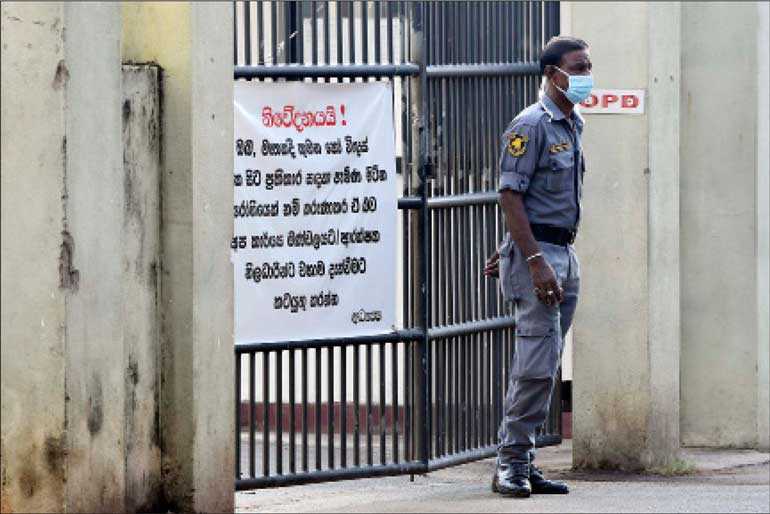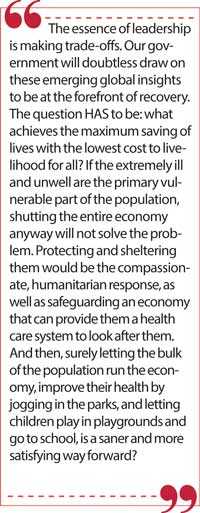Tuesday Dec 30, 2025
Tuesday Dec 30, 2025
Thursday, 16 April 2020 00:00 - - {{hitsCtrl.values.hits}}

The name “ili” refers to “influenza-like illness” and can be caused by the flu, strep throat, or indeed Covid-19. A new research paper by Justin Silverman and Alex Washburne (reported in The Economist this last week) highlights a “surge” in “non-flu” influenza-like diseases (ili). And its rise has the same  geographic pattern in the US as COVID-19 cases. This is as we’d expect presumably.
geographic pattern in the US as COVID-19 cases. This is as we’d expect presumably.
However, in total, estimated “non-flu ili” from 8 to 28 March for example was 200 times the positive COVID-19 tests in that period though!
Does that mean all these 23 million cases (the 200x) had COVID without being tested for it? It may not be that high, as we know “non-flu ili” does have other causes as stated. It could also be too low, as those who are asymptomatic or have mild COVID-19 indications may not have reported “non-flu ili” at all.
COVID-19 we are told takes 20-25 days to kill victims. The paper indicates that since say seven million Americans were infected in this way in the period 8 to 14 March, so we can see what the death statistics are three weeks out. Those statistics show 7,000 deaths, which would be an amazingly low fatality rate, in line with that of flu, roughly 0.1%, as the Stanford researcher John Ionnidis has been forecasting for some time. Studying South Korea, Iceland, Germany and Denmark, we do find, as partial corroboration, COVID-19 lethality is about 20 times lower than initially assumed by WHO!
If it is also true, as data from Iceland and now elsewhere suggests, that 50-80% of test-positive individuals remain symptom free, then the Oxford Study suggesting we have had waves of infection and may not only have starkly lower lethality but substantially more herd immunity, may also be increasingly confirmed.
Do lockdowns actually backfire?
I was told recently, in relation to Sri Lanka, though have not independently verified it, that virtually all of the recent cases that seem to have emerged in the last few weeks, despite curfew, have come out of the quarantine centres. And this leads us to consider the input we are hearing that the worst way to deal with viral respiratory diseases is to keep people indoors!
The data from Taiwan harmonises with Japanese data that, according to the CDC, shows transmission of the virus is 18.7 times greater indoors than outdoors. “In a study of 110 case-patients from 11 clusters in Japan, all clusters were associated with closed environments, including fitness centres, shared eating environments, and hospitals, the odds for transmission from a primary case-patient were 18.7 times higher than in open-air environments,” wrote two researchers in a report published by the CDC.
So, is locking everyone down – young and old, sick and healthy – together in families for extended periods of time the best strategy? How will we develop any measure of immunity, which is ultimately the only protection?
Lockdown proponents like Dr. Anthony Fauci in the US (though we must remember, there is no curfew anywhere in the US despite that) never seem to address that. Aside from all the terrible collateral damage of a shutdown, who is to say more people will not die and the virus’ shelf life won’t be extended by hindering nature’s natural coping mechanism rather than embracing it?
This is a red flag being thrown by prominent German American epidemiologist Dr. Knut M. Wittkowski. “With all respiratory diseases, the only thing that stops the disease is herd immunity.” Dr. Wittowski is a world-renowned epidemiologist who headed the Department of Biostatistics, Epidemiology, and Research Design at the Rockefeller University, New York for 20 years, and has been in the field for over 30 years. “About 80% of the people need to have had contact with the virus, and the majority of them won’t even have recognised that they were infected, or they had very, very mild symptoms, especially if they are children.”
As such, Dr. Wittkowski advocates for the exact opposite strategy. “So, it’s very important to keep the schools open and kids mingling to spread the virus to get herd immunity as fast as possible, and then the elderly people, who should be separated, and the nursing homes should be closed during that time, can come back and meet their children and grandchildren after about four weeks when the virus has been addressed.”
Needless to say, it follows that those of low risk, virtually everyone below 65, especially those with no underlying conditions, should still be able to run the economy, therefore in the meantime.
Wittkowski warns that under the current strategy, “If we are preventing natural immunity from developing, it is almost guaranteed that we have a second wave as soon as either we stop the social distancing or the climate changes with winter coming or something like that.”
Thus, even after causing countless deaths and permanent economic and mental health devastation from a lockdown for several months, we run a genuine risk of being back to square zero within a few days of ending the shutdown.
So, the real best practice response?
Let us keep in mind we face an unprecedented collapse in global trade, stock market crashes and the biggest increase in unemployment since the Great Depression. South Asia faces its own range of challenges, exacerbated each day the entire economy is shut down and livelihoods, businesses and options are indefinitely “frozen” and in some cases, potentially permanently destroyed.
And as the COVID numbers in South Asia are among the most “tame” globally, this further underlines the disconnect, panic decoupled from real data, and the currently “unseen” horrific toll to be confronted when the economic bill comes due. Ergo, we have to urgently pay attention to these insights, as we are learning we may not even be saving lives while inflicting grievous economic damage to ourselves.
A smattering of recently highlighted facts:
Let us return to “best practice.” It has to be: Test, Trace, Isolate and Identify High Risk Groups. Most countries have broken ALL of these rules. There was no early testing, infected people travelled, likely gave it to families and friends. They spread it. Those who got ill often indiscriminately went to hospitals and likely spread it to other sick people, perhaps precipitating superspreading events. South Korea, Taiwan and Norway are positive icons in this regard of actually applying this best practice and have the heartening mortality rates to show for it.
We need fresh air!
Data from five European countries suggests that care homes accounted for between 42% and 57% of all deaths related to COVID-19. The infections are almost all “nosocomial”. Care homes in Madrid have reported deaths of 4,260 residents of care homes from coronavirus. Almost all new cases in Spain are increasingly clustered in hospitals and retirement homes. Jerome Salomon, head of the public health authority in France confirms about a third of all deaths in France have come from within retirement communities.
Relative to the US, The New York Times reports: “The Times has identified more than 2,500 nursing homes and other long-term care facilities across the United States with coronavirus cases. More than 21,000 residents and staff members at those facilities have contracted the virus, and more than 3,800 have died.” The Times has tracked hundreds of clusters of coronavirus cases across the country it says, “The 10 deadliest have been in nursing homes and long-term care centres.”
One thing driving the spread in such situations, other than confinement, may be that such care facilities are a part of chains, and workers may be moving between them. There may also not be as scrupulous attention paid to hygiene and other factors as there should be, and you have a large group of people with multiple illnesses, living closely together.
Again, to reiterate, as of today, the virus appears to have minimal effects on children, low mortality impact below 65 even with pre-existing conditions, virtually no incidence below 65 without pre-existing conditions, and even above 65 a wide spread of lethality based on pre-existing conditions or what are being called “comorbidities”. It overwhelmingly afflicts those already sick.
Spanish data from Carlos III University finds that 70% of deaths were over 80, 20% between 70-79, men died at twice the rate of women. 74% of those dying had other conditions, 60% had heart conditions. Italy’s national health authority indicates 99% of mortalities had another condition. Almost half had at least three underlying illnesses. In the US, 80% of deaths roughly have been in those 65 and older, based on CDC estimates.
Children who have virtually no risk should be at school, developing immunity and antibodies, so they can be reunited with elderly family members! Why stunting their education and isolating them socially while retarding their immunological well-being is the preferred practice has yet to be explained!
Historically, plagues have been primarily bacteria based. The only real viral pandemic that caused global catastrophe objectively, as opposed to the at least partially self-inflicted global catastrophe underway today, is the 1918 Spanish Flu. That though largely targeted 20-30-year olds (akin to the 2009-2010 swine flu which was its descendant). Part of that may, in 1918, have been due to young soldiers returning home, spreading it to each other in cramped ships, barracks and infirmaries.
However, in 1918, British soldier Patrick Collins developed symptoms, and intuitively moved his tent up a hill away from his regiment. With clean air, and a ration of rum (literally!), he sweated, shivered, was occasionally delirious, but fought off the flu, and was one of the only survivors from his Cheshire regiment! He lived to 92.
Such regimens of fresh air, sunlight, scrupulous hygiene, face masks, with or without the rum, were used successfully to reduce deaths even in 1918 in cities like Boston, Massachusetts. This was further corroborated in the 1960s as biodefense researchers found outdoor air far more lethal to viruses than indoor air, with UV rays also acting as disinfectants which is why spring and summer usually see decline or increasing elimination of viral illnesses (unless everyone is locked up and the natural course of events is inhibited or paralysed!). Hence being locked up is particularly unfortunate in countries blessed with an abundance of UV “nutrition” year-round!
The virus, by the way, we are told by leading epidemiologists is not what kills, it is secondary bacterial pneumonia caused by common respiratory tract bacteria, which those at-risk are in particular more vulnerable to due to the virus.
The relatively horrific US numbers as another aside, still being adjusted down regularly with emerging data, are certainly amplified by the atrocious absence of universal health care and challenges re getting medical care for the unemployed and usually therefore uninsured, a “symptom” of a different, systemic non-COVID malaise.
So here seems to be the emerging prescription from “non-hysteria industry” experts
Remember, the mortality rate is either 5-6% (not itself cataclysmic compared to the alternative devastation of lives and livelihoods or compared to normal annual mortality numbers) if global reporting were fully correct, or potentially as low as 0.1% akin to the flu, if the numbers re the majority who are asymptomatic continues to hold up. Either way, the “certainty” of social and economic collapse is far more unambiguous and is as much about “lives” as this is.
None of the above measures therefore require indefinitely shutting down and undermining the whole economy. All these measures are more economically feasible and life affirming for almost everyone as well.
Moving forward
The essence of leadership is making trade-offs. Our government will doubtless draw on these emerging global insights to be at the forefront of recovery. The question HAS to be: what achieves the maximum saving of lives with the lowest cost to livelihood for all?
If the extremely ill and unwell are the primary vulnerable part of the population, shutting the entire economy anyway will not solve the problem. Protecting and sheltering them would be the compassionate, humanitarian response, as well as safeguarding an economy that can provide them a health care system to look after them.
And then, surely letting the bulk of the population run the economy, improve their health by jogging in the parks, and letting children play in playgrounds and go to school, is a saner and more satisfying way forward?